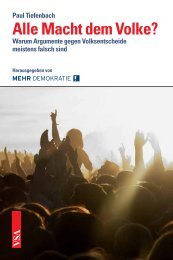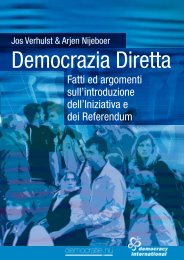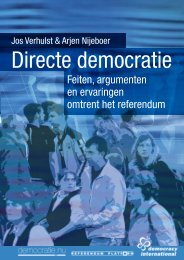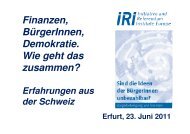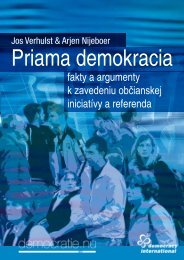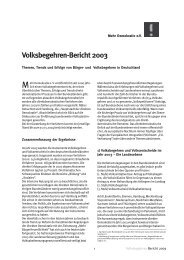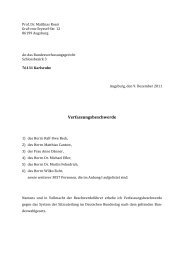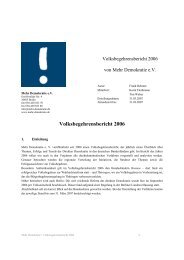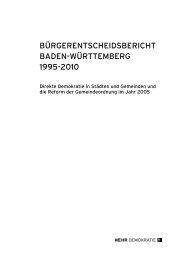Facts and Arguments about the Introduction of Initiative and ...
Facts and Arguments about the Introduction of Initiative and ...
Facts and Arguments about the Introduction of Initiative and ...
Create successful ePaper yourself
Turn your PDF publications into a flip-book with our unique Google optimized e-Paper software.
Hierarchy <strong>of</strong> laws<br />
A law that is approved by referendum must be higher in <strong>the</strong><br />
legal hierarchy than laws passed by parliament. There is an<br />
additional provision that a law approved directly by <strong>the</strong> people<br />
cannot subsequently be scrapped by parliament. After all,<br />
if a referendum is held, this means that <strong>the</strong> people want to<br />
express <strong>the</strong>ir own opinions <strong>about</strong> <strong>the</strong> issue concerned. With<br />
<strong>the</strong> referendum, <strong>the</strong> democratic m<strong>and</strong>ate is consequently<br />
placed in <strong>the</strong> h<strong>and</strong>s <strong>of</strong> <strong>the</strong> voters <strong>and</strong> not in those <strong>of</strong> <strong>the</strong><br />
members <strong>of</strong> parliament.<br />
In Switzerl<strong>and</strong>, this superiority <strong>of</strong> <strong>the</strong> people’s law is regulated<br />
at federal level by including <strong>the</strong> people’s law as part <strong>of</strong> <strong>the</strong> constitution.<br />
Because <strong>the</strong> Swiss constitution can only be changed<br />
via a referendum, this means that a decision by <strong>the</strong> people can<br />
only be abolished by ano<strong>the</strong>r decision by <strong>the</strong> people. The disadvantage<br />
is, however, that <strong>the</strong> Swiss constitution has developed<br />
into a strange mixture <strong>of</strong> general provisions (such as those that<br />
usually tend to appear in a constitution) <strong>and</strong> very specific stipulations<br />
(that are normally regulated by ordinary laws).<br />
That serious problems can arise on this point is shown by <strong>the</strong><br />
example <strong>of</strong> Oregon. The binding citizens’ initiative referendum<br />
exists in this US state but, by simple majority, <strong>the</strong> state<br />
parliament can abolish laws that are made by referendum.<br />
This has actually happened. In 1988, for example, a people’s<br />
initiative was carried which provided for longer prison sentences<br />
for violent criminals. This law was subsequently repealed<br />
by <strong>the</strong> legislative chambers.<br />
A popular initiative was later launched (Measure 33) in an<br />
attempt to prevent this type <strong>of</strong> occurrence. It proposed <strong>the</strong><br />
following:<br />
• laws created on <strong>the</strong> basis <strong>of</strong> a people’s initiative can only be<br />
changed in <strong>the</strong> first five years by ano<strong>the</strong>r people’s initiative;<br />
• after five years, a change can only be implemented if it secures<br />
at least 60% <strong>of</strong> <strong>the</strong> votes in both legislative chambers<br />
(Senate <strong>and</strong> House <strong>of</strong> Representatives).<br />
However, <strong>the</strong> proposal was rejected by only a narrow margin<br />
in November 1996.<br />
Participation quorums<br />
In view <strong>of</strong> <strong>the</strong> m<strong>and</strong>ate principle, it is absurd to introduce<br />
participation quorums for direct decision-making. The citizens<br />
who do not take part in a vote are considered to have<br />
given a m<strong>and</strong>ate to those who do. If one introduces participation<br />
quorums, one opens <strong>the</strong> door to boycott actions by minorities.<br />
Suppose, for instance, that <strong>the</strong>re is a participation<br />
quorum <strong>of</strong> 40% <strong>and</strong> that 60% <strong>of</strong> <strong>the</strong> electorate want to vote.<br />
Within <strong>the</strong> group keen to vote, 55% support <strong>the</strong> proposal to<br />
be voted on <strong>and</strong> 45% oppose it. The opponents cannot win<br />
<strong>the</strong> vote if <strong>the</strong>y take part in <strong>the</strong> referendum. But if <strong>the</strong>y stay<br />
at home, however, <strong>the</strong>y can ‘win’, because <strong>the</strong>n <strong>the</strong> 40% quorum<br />
will not be achieved <strong>and</strong> <strong>the</strong> proposal will be rejected,<br />
against <strong>the</strong> will <strong>of</strong> <strong>the</strong> majority [see 2-2].<br />
We have seen that <strong>the</strong> parliamentary m<strong>and</strong>ate is only a derived<br />
form <strong>of</strong> <strong>the</strong> m<strong>and</strong>ate which <strong>the</strong> effective voters receive<br />
in direct-democratic decision-making. A parliament contains<br />
on average only <strong>about</strong> 0.003% <strong>of</strong> <strong>the</strong> population <strong>and</strong> yet it<br />
can still make decisions. So it makes no sense to suddenly introduce<br />
participation quorums <strong>of</strong> 20% or 40% for <strong>the</strong> ad hoc<br />
parliament that is formed by a referendum. The mistake that<br />
1<br />
is made with participation quorums is that <strong>the</strong> people who<br />
stay at home are counted as ei<strong>the</strong>r supporters or opponents<br />
(depending on <strong>the</strong> referendum). In reality, <strong>the</strong>y have chosen<br />
not to voice <strong>the</strong>ir opinion. That must be respected.<br />
Finally, we can also note that <strong>the</strong> turnout for a referendum<br />
must not be compared with <strong>the</strong> turnout for elections. In elections,<br />
all kinds <strong>of</strong> issues are on <strong>the</strong> agenda or in <strong>the</strong> party<br />
manifestos: <strong>the</strong> current ones <strong>and</strong> all <strong>the</strong> new topics that may<br />
present <strong>the</strong>mselves in <strong>the</strong> next four or five years. A referendum<br />
has only one specific issue on <strong>the</strong> agenda, so it is logical<br />
that <strong>the</strong> turnout for this is lower than for elections.<br />
<strong>Arguments</strong> are sometimes put forward for a low quorum,<br />
precisely to avoid possible boycotting. However, this st<strong>and</strong>point<br />
is illogical. Ei<strong>the</strong>r a quorum is so low that it is bound to<br />
be met: <strong>the</strong>n, to be sure, boycotting is ruled out – but at <strong>the</strong><br />
same time <strong>the</strong> quorum itself is pointless. Or <strong>the</strong> quorum is<br />
so high that it is unlikely ever to be achieved: <strong>the</strong>n boycotting<br />
is possible. There is no third possibility.<br />
It also needs to be remembered that participation quorums<br />
are basically impossible for parliamentary or municipal council<br />
elections. After all, if such a quorum were not to be met,<br />
<strong>the</strong> legislative <strong>and</strong> administrative system would just grind to<br />
a halt. There are no good reasons for not having a quorum for<br />
this kind <strong>of</strong> election but insisting on one for referendums. If<br />
<strong>the</strong> group making a decision by referendum is required to<br />
be ‘sufficiently representative’, <strong>the</strong>n <strong>the</strong> same requirement<br />
must apply a fortiori (even more stringently) for parliamentary<br />
elections. Suppose that a participation quorum <strong>of</strong> 25% is<br />
set for a referendum <strong>and</strong> at <strong>the</strong> same time no quorum is set<br />
for parliamentary elections. A referendum in which 20% <strong>of</strong><br />
<strong>the</strong> electorate votes will be declared invalid. But a parliament<br />
that is elected by only 5% <strong>of</strong> <strong>the</strong> electorate, however, can still<br />
make ‘legitimate’ decisions – decisions based on an indirect<br />
citizen participation <strong>of</strong> 5% – whereas <strong>the</strong> rejected referendum<br />
result can boast a direct citizen participation <strong>of</strong> 20%.<br />
That is illogical. Moreover, <strong>the</strong> m<strong>and</strong>ate that is given to parliament<br />
is much more far-reaching than <strong>the</strong> m<strong>and</strong>ate given<br />
to <strong>the</strong> voters by those who stay at home in a referendum.<br />
After all, nothing can be said with certainty <strong>about</strong> what farreaching<br />
decisions will be made by all <strong>the</strong> members <strong>of</strong> parliament.<br />
During <strong>the</strong> course <strong>of</strong> a parliamentary sitting, new<br />
topics <strong>and</strong> draft legislation that could not have been foreseen<br />
are constantly being put onto <strong>the</strong> agenda.<br />
Finally, some supporters <strong>of</strong> a participation quorum refer to <strong>the</strong><br />
so-called danger <strong>of</strong> ‘compartmentalisation’. By this <strong>the</strong>y mean<br />
that citizens would only vote for <strong>the</strong> issues which <strong>the</strong>ir own<br />
group is concerned <strong>about</strong>. For instance, in a referendum on<br />
an action plan to deal with farmyard manure, only <strong>the</strong> small<br />
section <strong>of</strong> <strong>the</strong> population who are cattle farmers would vote.<br />
This objection rests on <strong>the</strong> false premise that people only<br />
vote to defend <strong>the</strong>ir own group’s interests. The reality is different<br />
(see chapter 6, point b). In countries or states without<br />
participation quorums, such as Switzerl<strong>and</strong> <strong>and</strong> California,<br />
<strong>the</strong>re is no evidence <strong>of</strong> ‘compartmentalisation’. The practical<br />
progress <strong>of</strong> direct-democratic votes makes any ‘compartmentalisation<br />
effect’ improbable a priori. For example, on any<br />
one referendum voting day in Switzerl<strong>and</strong> <strong>the</strong>re are almost<br />
always several referendum issues to be voted on at <strong>the</strong> same<br />
time. These referendums are on <strong>the</strong> most diverse subjects<br />
<strong>and</strong> concern not only <strong>the</strong> federal <strong>and</strong> cantonal levels, but also<br />
<strong>the</strong> municipal level. Thus people are not normally called to<br />
<strong>the</strong> ballot box for <strong>the</strong> sake <strong>of</strong> one single specialised issue.




